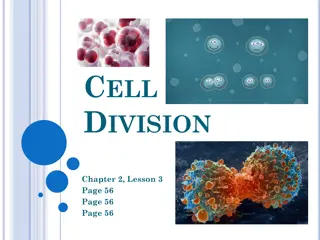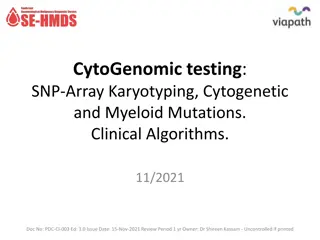Understanding B-Cell Prolymphocytic Leukaemia and CLL-Related Conditions
B-cell prolymphocytic leukaemia (B-PLL) is a rare disorder that mainly affects older patients, presenting with splenomegaly and high white blood cell counts. CLL-related conditions like Monoclonal B-cell lymphocytosis and Richter's syndrome can further complicate the prognosis, especially in elderly patients with comorbidities. The diagnosis of B-PLL relies on identifying prolymphocytes in blood films, with a percentage greater than 55% indicative of the disease. Gender and age play a significant role in prognosis, with men and older individuals having a higher risk and poorer outcomes. Comorbidities, especially impaired renal function, can impact treatment options and patient fitness for certain therapies.
Download Presentation

Please find below an Image/Link to download the presentation.
The content on the website is provided AS IS for your information and personal use only. It may not be sold, licensed, or shared on other websites without obtaining consent from the author. Download presentation by click this link. If you encounter any issues during the download, it is possible that the publisher has removed the file from their server.
E N D
Presentation Transcript
CLL-related conditions Monoclonal B-cell lymphocytosis (MBL) Small lymphocytic lymphoma (SLL) Richter s syndrome (RS) Richter s syndrome (RS) represents the development of an aggressive lymphoma, most commonly a diffuse large B-cell lymphoma (DLBCL) in a patient previously (or simultaneously) diagnosed with CLL. The diagnosis needs to be substantiated by the biopsy of a lymph node or another lymphoid tissue. Rarely, RS presents in peripheral blood or bone marrow smears
Prognosis of CLL Age older patients have a poorer prognosis than younger ones Sex The incidence of CLL is higher in men than in women. The reason for this imbalance is unclear. In addition, females appear to have a longer survival than males
Comorbidity The median age of patients at diagnosis is over 70 years. As a result, the presence of concurrent diseases is frequent. Although a specific index to evaluate comorbidity and frailty in patients with this form of leukaemia does not exist, a modified Cumulative Illness Rate Score (CIRS) of greater than 6 has been used by the German CLL Study Group to define patients considered unfit for fludarabine-based therapy. Particularly important is an impaired renal function (creatinine clearance <70 mL/min), which is associated with poor tolerance to chemoimmunotherapy and higher toxicity.
B-cell prolymphocytic leukaemia (B-PLL) is an extremely rare disorder In fact, most cases of B-PLL correspond to MCL in leukaemic phase. The diagnosis is mainly based on morphology and cell markers Studies addressing differences in gene expression profiling between B-PLL and CLL have yield discordant results. The mean age of patients is 70 years and the chief presenting features are splenomegaly without lymphadenopathy and a high WBC count, usually >100 109/L. Anaemia and thrombocytopenia are seen in at least 50% of cases. Other laboratory findings are no different from high-WBC-count CLL, but the incidence of a monoclonal band appears to be higher than in CLL.
The main diagnostic criterion is the identification of prolymphocytes as the predominant population in blood films. A percentage of prolymphocytes >55% is the arbitrary cut- off to diagnose B-PLL. The prolymphocyte is twice the size of a small CLL lymphocyte, hasmoderately condensed nuclear chromatin, a prominent central nucleolus and a lower nucleus-to- cytoplasm ratio than CLL cells
Hairy cell leukaemia Hairy cell leukaemia (HCL) is an uncommon B cell lymphoproliferative Disease with a male : female ratio of 4 : 1 peak incidence at 40 60 years. Patients typically present with infections, anaemia splenomegaly. Lymphadenopathy is uncommon. Pancytopenia is usual at presentation and the lymphocyte count is rarely over 20 109/L. Monocytopenia is a distinctive feature. The blood film reveals a variable number of unusual large lymphocytes with villous cytoplasmic projections
Immunophenotyping shows CD11c, CD19, CD25, CD103 and CD123 positivity in most cases . A mutation in exon 15 of the gene for the protein kinase BRAF underlies the disease. The bone marrow trephine shows a characteristic appearance of mild fibrosis and a diffuse cellular infiltrate
treatments There are several effective treatments for HCL and the median relapse free survival after chemotherapy is 16 years. The treatment of choice is 2 chlorodeoxyadenosine (CDA) or deoxycoformycin (DCF) and both agents achieve complete responses in over 80% of cases. In two thirds of cases a long term remission is achieved. interferon is also effective and is sometimes used first for those with severe cytopenias to improve these before the more effective drugs, which initially tend to lower the neutrophil and platelet counts, are given. Rituximab can be combined with CDA or DCF for relapsed cases. BRAF inhibitors are potentially useful in rare cases of refractory disease.
Lymphocytosis in nonHodgkin lymphomas Some cases of splenic marginal zone lymphoma show circulating monoclonal B lymphocytes with a villous cell outline and were previously termed splenic lymphoma with villous lymphocytes Lymphocytosis may also be seen in other types of non Hodgkin lymphoma (e.g. follicular,mantle cell, diffuse large B cell)
Tcell diseases T cell prolymphocytic leukaemia This presents as B PLL with a high white cell count, but lymphadenopathy is more marked and skin lesions and serous effusions are common. Most tumours express CD4+. Treatment is with alemtuzumab followed by SCT in appropriate patients
Large granular lymphocytic leukaemia Large granular lymphocytic leukaemia (LGL L) is characterized by the presence of circulating lymphocytes with abundant cytoplasm and large azurophilic granules Such cells may be either T or natural killer (NK) cells and show variable expression of CD16, CD56 and CD57. STAT3 mutations are present in 50% of cases
Cytopenia, especially neutropenia, is the main clinical problem, although anaemia, splenomegaly and arthropathy with positive serology for rheumatoid arthritis are also common. The mean age is 50 years. Treatment May not be needed, but, if required, steroids, cyclophosphamide, ciclosporin or methotrexate may relieve the cytopenia. Granulocyte colony stimulating factor (G CSF) has been used in cases associated with neutropenia
Adult Tcell leukaemia/lymphoma Adult T cell leukaemia/lymphoma (ATLL) was the first malignancy to be associated with a human retrovirus, human T cell leukaemia/lymphoma virus type 1 (HTLV 1). The virus is endemic in parts of Japan and the Caribbean and the disease is very rare in people who have not lived in these areas. ATLL lymphocytes have a bizarre morphology with a convoluted clover leaf nucleus and a consistent CD4+ phenotype Most subjects infected with the virus do not develop the disease. The clinical presentation is often acute and dominated by hypercalcaemia, skin lesions, hepatosplenomegaly and lymphadenopathy.
Diagnosis is by morphology and serology. Zidovudine, an anti retroviral drug, and alpha interferon are first line therapy if leukaemia is dominant but combination chemotherapy is used if the presentation is more like a lymphoma. The prognosis is poor.























